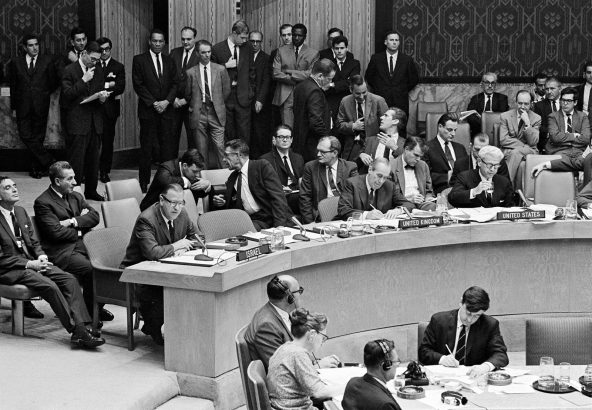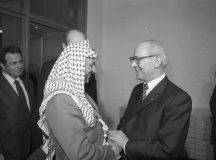The logic of UN Resolution 242 – that this is a conflict of two sides with rights and responsibilities, and that Israel’s withdrawal requirements have to be tied to reinforcing Israel’s legitimacy and security – remains sound, claims Fathom Associate Editor Toby Greene. International actors should use this moment to reaffirm the principles set down in November 1967. The pursuit of approaches that seek to avoid that logic, only push a resolution further away.
Fifteen hands, two principles
The occupation goes back 50 years, but so too does the internationally-agreed framework for ending it. It was around 4.30pm, on a bracing New York Wednesday afternoon, 22 November 1967, that representatives of 15 nations at the UN Security Council table raised their hands to pass Resolution 242. This text, a mere 291 words, contains the only agreed terms of reference in each of Israel’s peace accords with Egypt, Jordan and the Palestinians.
It is a framework built around two parallel principles: Israeli territorial withdrawal on the one hand, and recognition of Israel’s right to exist in ‘secure and recognised boundaries’ on the other. This ‘land for peace’ trade-off has defined Arab-Israeli peace making. But why has it not yet allowed the Israeli-Palestinian conflict to be resolved, is it still relevant, and what can international actors learn from 242 about promoting conflict resolution today?
The historic and artful 242
Whilst it took Israel just six days to flatten its Arab enemies in battle, it took the great powers five months of frustrated backroom haggling to agree 242. That the Cold War titans, the US and Soviet Union, advocates of Israeli and Arab positions respectively, could agree at all, showed that a war born of crisis, had created opportunity.
Israel’s establishment in 1948 came after the UN endorsed a plan to partition Palestine into Jewish and Arab states. The Arab rejection of that proposal led to the first Arab-Israeli war, resulting in Israel’s establishment within precarious ceasefire lines, and the flight of hundreds of thousands of Palestinian Arabs from the territory of the new Jewish state.
From 1949 until 1967, Israel’s Arab neighbours were united by the commitment to reversing the events of 1948 and destroying Israel, threatening to do so in blood curdling terms. June 1967 ended this hope. Arab goals moderated to securing the restoration of the territory it had lost in the 1967 war: the West Bank, East Jerusalem, the Gaza Strip, the Sinai Peninsula and the Golan Heights. Resolution 242 was made possible through the realisation among international diplomats that this could be compatible with Israel’s central goals: respect for its sovereignty and its ‘right to live in peace within secure and recognised boundaries free from threats’.
Balancing these positions was a delicate business. No less than five separate drafts lay on the Security Council desk that Wednesday. But it was British Ambassador Hugh Foot, Lord Caradon – a former Cambridge Union president from an impressive political family including younger brother Michael Foot – whose deft diplomatic and textual manoeuvres finally won the day.
Critically, the central principles were presented in parallel. If Israel wanted legitimacy and security it needed to withdraw from territories. But equally, if the Arab side wanted its territories back, Israel needed legitimacy and security. Whilst there was enough substance to make the text meaningful, Caradon achieved unanimity by creating enough ambiguity, such that each side could frame its interests in the context of the resolution.
Israel could interpret the resolution as requiring from the Arabs full recognition and negotiated peace agreements, though this was not explicit. Similarly, the Arabs could interpret the resolution as requiring full Israeli withdrawal, though the wording artfully avoided doing so, since Israel could not have accepted it.
Whilst the resolution calls for ‘withdrawal of Israeli armed forces from territories occupied in the recent conflict,’ it famously omits the words ‘all’ or ‘the’ before ‘territories’. Israel has always claimed it means only some of the territories, and the Arab side that it means all territories, which they bolster by pointing to an earlier clause emphasising ‘the inadmissibility of the acquisition of territory by war’. Israeli negotiators maintain that while the resolution refers to ‘the inadmissibility of the acquisition of territory by war,’ that does not preclude the inadmissibility of the acquisition of territory by agreement. The language of ‘secure and recognised boundaries,’ alongside the language on ‘withdrawal’ gave force to Israel’s position that the borders need to be defined anew.
In 1967 Israel was adamant that it could not be forced back to the status quo ante – the perilously insecure 1949 armistice lines, which had laid the basis for the 1967 war, and which British Labour Cabinet Minister Richard Crossman called ‘impossible peace frontiers’.
Resolution 242 did not (on its own) legally bind the parties. As a Chapter VI resolution, according to the UN Charter, it recommended principles that the parties should adopt in negotiations to resolve the conflict. What made 242’s terms binding were the Israeli-Egyptian, Israeli-Jordanian and Israeli-Palestinian agreements in their bilateral relations to use 242 as a term of reference.
But while Israel, Egypt and Jordan (but not Syria) all separately accepted 242 in the months following its passage, it took another bloody war, in 1973, to convince both Egypt and Israel that its best interests lay in implementing it. When the shooting stopped and the talking began, it was on the sole basis of 242 and Resolution 338 (which reaffirmed the terms of 242 and called for negotiations based upon it) that Egypt and Israel constructed the 1978 Camp David Accords, a cornerstone of regional stability for nearly 40 years.
From 242 to two (states) for two (peoples)
Back in 1967, Resolution 242 was seen as a setback by the nascent Palestine Liberation Organisation (PLO). Not only did it reinforce Israel’s legitimacy within secure boundaries, but Palestinian national claims were conspicuous only by their absence. The Palestinians are referred to only indirectly, through the call for ‘achieving a just settlement of the refugee problem’.
Up to 1967 the Palestinian refugee issue was subsumed within the wider pan-Arab agenda to undo the creation of Israel, and in the immediate wake of the war, the idea of an independent Palestinian state was not prominent. Caradon recalled: ‘We all took it for granted that the occupied territory would be restored to Jordan.’
It was the acrid smell of devastated tanks and aircraft that caused Arab dreams of militarily undoing Israel to ebb, allowing the PLO to emerge as an independent voice and the demand for a Palestinian state to take prominence. Yet for 20 years under Yasser Arafat’s leadership, the PLO remained adamantly committed to replacing Israel, not making peace with it. It took regional changes to shift Arafat’s policy: Anwar Sadat and Menachem Begin shaking hands; the exile of the weakened PLO leadership to Tunisia after the First Lebanon War; Palestinian youth seizing the initiative in the First Intifada; and finally King Hussein of Jordan’s decision to renounce claims on the West Bank in 1988.
It was in the Algiers Declaration in 1988, where Arafat, as leader of the PLO, declared symbolically the independence of a Palestinian state and called for an international conference on the basis of 242. This implied PLO recognition that Palestinian national rights would be pursued in the West Bank and Gaza but not in sovereign Israel. That recognition by Arafat paved the way for a PLO-US dialogue, and in due course made possible the Oslo peace process itself. In the 1993 Declaration of Principles and the subsequent Israeli-Palestinian agreements, the only agreed terms of reference are 242 and 338.
Israeli-Palestinian peace making was anchored therefore within 242’s twin principles: Israeli withdrawal from territories captured in 1967 alongside Israel’s right to ‘peace within secure and recognised boundaries free from threats or acts of force’. This belies the framing of the conflict as being simply about ending the occupation. Resolution 242 made clear that it was about competing claims and rights that need to be balanced in a negotiating process.
Establishing special security arrangements to address the threats Israel faces has been an important issue in all final-status negotiations since 1993. Israel shares in the responsibility to end Palestinian indignity and suffering, but not to critically undermine its own population’s security in the process. This position is anchored in another of 242’s terms, which affirms the necessity of ‘guaranteeing the territorial inviolability and political independence of every State in the area, through measures including the establishment of demilitarised zones’. Key to concluding the peace treaty between Israel and Egypt was the decision to demilitarise the Sinai. A broadly accepted principle of the Israeli-Palestinian peace process is that a future Palestinian state would be demilitarised or have very limited arms.
The logic of 242 ties Israel’s withdrawal to security in very clear ways because the security threat to Israel was what triggered the 1967 conflict. Israel’s pre-emptive strike on June 5 was widely recognised at the time as a legitimate act of self-defence against Arab forces mobilising on its narrow and vulnerable frontiers and threatening its destruction.
Whilst today Israel is not threatened by Soviet backed Arab armies, the principle of special security measures including demilitarisation remains relevant due to the proliferation and growing power of non-state armed actors. No Israeli leader can persuade their public that it is a good idea to transfer sovereignty in the West Bank unless he can persuade them that there will not be rockets and other threats emerging, as was the case after Israel’s withdrawal from the Gaza Strip in 2005. The fear of a Palestinian state becoming a failed state or a terror state is one of the core concerns for Israel. This underpins Israeli demands for a sustained Israeli military presence in the Jordan Valley to prevent the infiltration of weapons and fighters into the West Bank – a sticking point in the 2013-14 Israeli-Palestinian negotiations led by then US Secretary of State John Kerry.
The limits of Two Four Two
Resolution 242 is not exhaustive. Whilst the land for peace trade-off captured the essence of peace making between Israel and Egypt (and similar failed efforts with Syria), the conflict between Israel and the Palestinians is about more than real estate. It is also about two national identities rooted in the same territory.
The events of 1948 – the establishment of a Jewish nation state and the birth of the Palestinian refugee problem – at least as much as the events of 1967, define the Israeli-Palestinian conflict. Resolution 242 affirms the necessity of ‘achieving a just resolution of the refugee problem’ but without specifying how.
For Israel, a core trade-off for the establishment of a Palestinian nation state in the occupied territories, is Palestinian renunciation of their claims to the territory of Israel, including the claimed ‘right of return’ for refugees from 1948 and their descendants. This demand is understood by Israelis as a threat to Israel’s very existence as the nation state of the Jewish people. This is one of the drivers behind Israel’s claim that in an agreement which establishes Palestine as the nation state of the Palestinians, the Palestinians should recognise that Israel is the nation state of the Jewish people.
Just as Resolution 242 did not address Palestinian national claims, nor does it deal with the special attachment of the Jewish people to the West Bank (Judea and Samaria) and Jerusalem. These areas are deeply connected to the Jewish people, which were also part of the Jewish national home pledged by the League of Nations in 1922. The issue has taken on a new significance with the settlement of Israelis in the West Bank since 1967.
Whilst 242 does not address these issues, it nonetheless incorporates principles which provide the basis for addressing them. The need for Israel to withdraw, creating the possibility for Palestinian sovereignty; the possibility of agreed territorial adjustments, which can incorporate settlements into Israel; and above all the need to establish a balanced basis for all peoples in the region to enjoy ‘territorial inviolability and political independence’.
Lessons for future drafters
Many UN resolutions have been passed on the Arab-Israeli conflict, but only the substance of 242 is accepted by both sides as terms of reference for a conflict ending agreement.
Other resolutions have reflected the UN being used as a stage for the parties to act out their differences, rather than the forum for resolving them. Resolution 2334, passed in December 2016 in condemnation of Israeli settlements, was promoted by the Palestinians to advance their agenda, presenting settlements as the core obstacle to achieving an outcome with only minimal reference to Israeli concerns.
Whilst the resolution reflected understandable frustration at Israeli settlement policies, by playing into the hands of one narrative, the UN sent a message to the Palestinian side that it is possible to achieve outcomes without coming to terms with Israel. This was the opposite of 242, which provided guiding principles, but placed the onus on the parties to accept one another’s legitimacy to achieve a mutually desirable outcome.
In recent years the Palestinians have moved away from establishing a state through bilateral negotiations, to attempting unilaterally to construct Palestine as an international legal reality. This process has not changed the situation on the ground, underlining that the ‘withdrawal of Israeli armed forces’ cannot be secured through international resolutions alone, but only through a decision of Israel that this reflects its interests, and enhances its ability to ‘live in peace within secure and recognised boundaries free from threats or acts of force’.
Concern at the lack of progress in bilateral talks, and fears that the two-state solution may expire, has prompted some to propose international terms for ending the conflict be imposed on the parties. However, any policy, statement or action from the international community needs to be measured against the metric: is it going to bring the parties closer to dialogue and to mutual recognition?
Both Israelis and Palestinians demonstrated in their negative reaction to Kerry’s speech on the peace process in December 2016, that neither party wants to feel it is being disenfranchised from their own process and being forced to do what others are telling them. External dictates also risk emboldening less conciliatory forces on both sides, who garner legitimacy by positioning themselves as defenders against international parameters not reflecting their side’s interests.
Rights and Responsibilities
Having a framework for resolving the conflict is not enough. While the belief that change is possible is necessary, it is badly lacking due to the regional situation and the experiences of both societies, which has heightened mutual distrust and anxiety.
In that context, the 50-year anniversary can fuel international concerns that the conflict is unending, and lead some to seek alternatives to a two-state solution built on the framework of 242. But the problem is not with the principles that shape how we think about this conflict; the problem is the commitment to apply those principles.
Though the Israeli-Palestinian bilateral track has run aground, there are ways, as a recent BICOM paper outlines, for making progress: incentivising tools of constructive unilateralism; working with Arab states to create a regional umbrella; rebooting civil society peace initiatives; and rebuilding bilateral talks out of the public eye, which can reverse the negative trends.
The logic of 242 – that this is a conflict of two sides with rights and responsibilities, and that Israel’s withdrawal requirements have to be tied to reinforcing its security and legitimacy – remains sound. International actors should use this moment to reaffirm those principles. It is the pursuit of approaches that seek to avoid that logic, more than the insistence on that logic, which pulls us away from resolving the conflict.
The author would like to thank an individual with long experience of Israeli-Palestinian peace making interviewed for this essay whose insights were invaluable.









































Like many pro Israeli supporters when writing about the possibilities of peace in the Israel Palestine conflict Greene is no different: he conflates the issue and ignores the legal responsibilities which Israel refuses to accept, especially those found in UNSC242.
Greene refers to rights and responsibilities of both sides in the conflict within the context of 242. In particular “Israel’s withdrawal requirements have to be tied to reinforcing its security and legitimacy.”
Israel has refused to withdraw for those territories but has secured safe boundaries and recognition of legitimacy due to the peace agreements with Egypt and Jordan. The Israel argument is redundant within the context of the territories (The West Bank and Gaza ). Finally, in September 1993 the PLO, in a letter written to PM Rabin, formally recognised Israel’s right to exist “in peace and security”.
Greene also throws doubt about the meaning of withdrawl: does it imply all territory? The response from the author is one of deception. What is meant by withdrawl from “territories occupied”? Ask any school student and the reply would be “get out of the land that Israel occupied during the war….period. Furthermore, if one was to read the SC records it is obvious to all and sundry that 2/3rds of the participants were in agreement that Israel was to withdraw from “ALL” territory.
Greene also throws doubt about the “legality” of 242 with his reference to it being non-binding. Once again he attempts to evade the truth of 242. The UNSC resolution embodies legal principles which are binding in themselves. The obligitation to abide by them is independent of the instrument such as 242. The preamble to 242 clearly states the obligation required to the principle that territory cannot be acquired through the use of force.
It is sad to read that Greene has gone to such depths to pervert the meaning of 242. One can only conclude that such an underhanded interpretation, which is not uncommon to come across, is a massive impediment to reaching peace in the Israel Palestine conflict.
Hmmm.
Only military forces need withdraw.
You couldn’t comment on that?